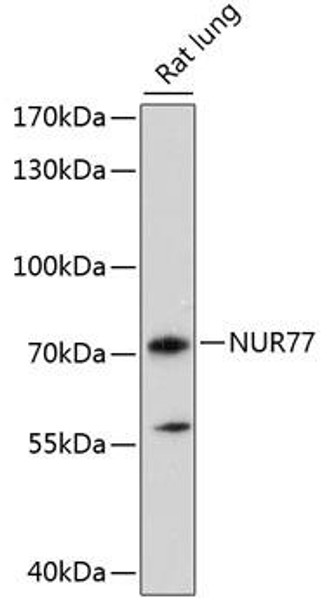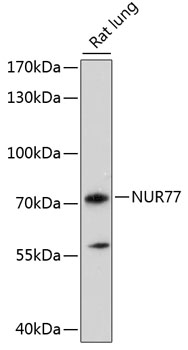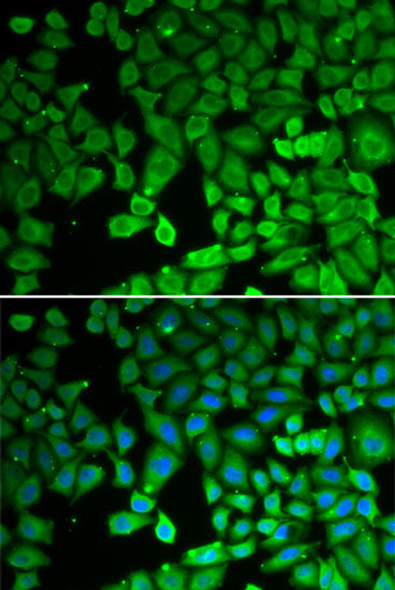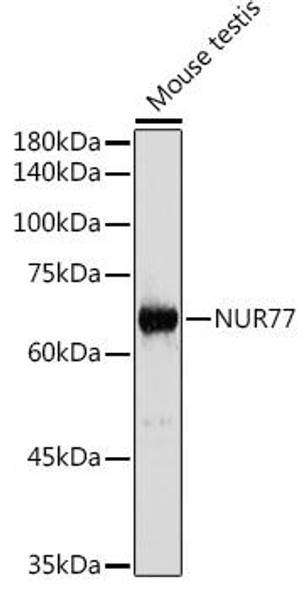Anti-NUR77 Antibody (CAB16264)
- SKU:
- CAB16264
- Product type:
- Antibody
- Reactivity:
- Human
- Rat
- Host Species:
- Rabbit
- Isotype:
- IgG
- Antibody Type:
- Polyclonal Antibody
- Research Area:
- Epigenetics and Nuclear Signaling
Description
| Antibody Name: | Anti-NUR77 Antibody |
| Antibody SKU: | CAB16264 |
| Antibody Size: | 20uL, 50uL, 100uL |
| Application: | WB |
| Reactivity: | Human, Rat |
| Host Species: | Rabbit |
| Immunogen: | A synthetic peptide corresponding to a sequence within amino acids 200-300 of human NUR77 (NP_775180.1). |
| Application: | WB |
| Recommended Dilution: | WB 1:500 - 1:2000 |
| Reactivity: | Human, Rat |
| Positive Samples: | Rat lung |
| Immunogen: | A synthetic peptide corresponding to a sequence within amino acids 200-300 of human NUR77 (NP_775180.1). |
| Purification Method: | Affinity purification |
| Storage Buffer: | Store at -20°C. Avoid freeze / thaw cycles. Buffer: PBS with 0.02% sodium azide, 50% glycerol, pH7.3. |
| Isotype: | IgG |
| Sequence: | PSLA QSPL KLFP SQAT HQLG EGES YSMP TAFP GLAP TSPH LEGS GILD TPVT STKA RSGA PGGS EGRC AVCG DNAS CQHY GVRT CEGC KGFF KRTV QKNA K |
| Gene ID: | 3164 |
| Uniprot: | P22736 |
| Cellular Location: | Cytoplasm, Nucleus |
| Calculated MW: | 33kDa/64kDa/65kDa |
| Observed MW: | 70kDa |
| Synonyms: | NR4A1, GFRP1, HMR, N10, NAK-1, NGFIB, NP10, NUR77, TR3 |
| Background: | This gene encodes a member of the steroid-thyroid hormone-retinoid receptor superfamily. Expression is induced by phytohemagglutinin in human lymphocytes and by serum stimulation of arrested fibroblasts. The encoded protein acts as a nuclear transcription factor. Translocation of the protein from the nucleus to mitochondria induces apoptosis. Multiple transcript variants encoding different isoforms have been found for this gene. |
| UniProt Protein Function: | Nur77: an orphan nuclear receptor and immediate-early gene that regulates cellular proliferation, apoptosis, inflammation, and glucose metabolism. Induced by exercise in muscle and is a functional regulator of glucose metabolism in skeletal muscle. Its level decreases in the muscle of obese insulin-resistant men. Acts concomitantly with NURR1 in regulating the expression of delayed-early genes during liver regeneration. Binds the NGFI-B response element (NBRE) 5'-AAAAGGTCA-3'. May inhibit NF-kappa-B transactivation of IL2. A mediator of TCR-directed thymocyte apoptosis. TCR-signaling induces a FAIM/Akt/Nur77 signaling pathway that is critical for modulating apoptosis in developing thymocytes. A physiological substrate of the MEK-ERK-RSK cascade that modulates nuclear export and intracellular translocation during T cell death. Binds DNA as a monomer. Interacts with GADD45GIP1. Overexpression of Nur77 induces the expression of both p300 and HDAC1. Acetylation by p300 and HDAC1 may regulate the rapid turnover of Nur77 protein. |
| UniProt Protein Details: | Protein type:Nuclear receptor; Apoptosis; DNA-binding Chromosomal Location of Human Ortholog: 12q13 Cellular Component: nucleoplasm; nuclear membrane; cytoplasm; nucleus Molecular Function:protein binding; ligand-dependent nuclear receptor activity; DNA binding; zinc ion binding; sequence-specific DNA binding; steroid hormone receptor activity Biological Process: epidermal growth factor receptor signaling pathway; transcription initiation from RNA polymerase II promoter; phosphoinositide-mediated signaling; intracellular receptor-mediated signaling pathway; fibroblast growth factor receptor signaling pathway; cell migration during sprouting angiogenesis; nerve growth factor receptor signaling pathway; innate immune response; positive regulation of endothelial cell proliferation; positive regulation of transcription from RNA polymerase II promoter; steroid hormone mediated signaling; gene expression; signal transduction |
| NCBI Summary: | This gene encodes a member of the steroid-thyroid hormone-retinoid receptor superfamily. Expression is induced by phytohemagglutinin in human lymphocytes and by serum stimulation of arrested fibroblasts. The encoded protein acts as a nuclear transcription factor. Translocation of the protein from the nucleus to mitochondria induces apoptosis. Multiple transcript variants encoding different isoforms have been found for this gene. [provided by RefSeq, Jan 2011] |
| UniProt Code: | P22736 |
| NCBI GenInfo Identifier: | 127819 |
| NCBI Gene ID: | 3164 |
| NCBI Accession: | P22736.1 |
| UniProt Secondary Accession: | P22736,Q15627, B4DML7, |
| UniProt Related Accession: | P22736 |
| Molecular Weight: | 64,463 Da |
| NCBI Full Name: | Nuclear receptor subfamily 4 group A member 1 |
| NCBI Synonym Full Names: | nuclear receptor subfamily 4, group A, member 1 |
| NCBI Official Symbol: | NR4A1 |
| NCBI Official Synonym Symbols: | HMR; N10; TR3; NP10; GFRP1; NAK-1; NGFIB; NUR77 |
| NCBI Protein Information: | nuclear receptor subfamily 4 group A member 1; ST-59; hormone receptor; TR3 orphan receptor; steroid receptor TR3; testicular receptor 3; early response protein NAK1; orphan nuclear receptor HMR; orphan nuclear receptor TR3; nuclear hormone receptor NUR/77; growth factor-inducible nuclear protein N10; nerve growth factor IB nuclear receptor variant 1 |
| UniProt Protein Name: | Nuclear receptor subfamily 4 group A member 1 |
| UniProt Synonym Protein Names: | Early response protein NAK1; Nuclear hormone receptor NUR/77; Nur77; Orphan nuclear receptor HMR; Orphan nuclear receptor TR3; ST-59; Testicular receptor 3 |
| Protein Family: | Nuclear receptor subfamily |
| UniProt Gene Name: | NR4A1 |
| UniProt Entry Name: | NR4A1_HUMAN |










